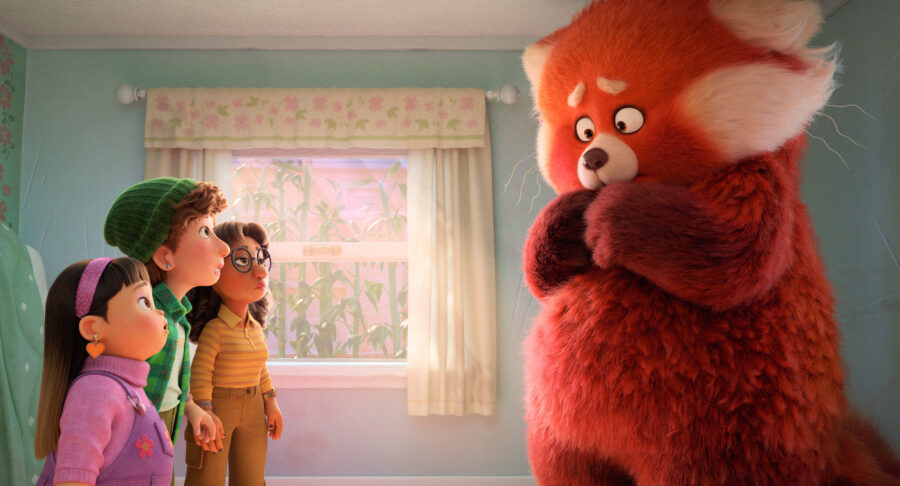Turning Red Review: Pixar’s Newest Is Heartfelt And A Little Too Hyper
Turning Red delivers another Pixar piece of movie magic, but is it going to alienate some viewers with its subject matter and themes? Read our review!
This article is more than 2 years old

Turning Red is not going to be for everyone. That’s an odd thing to say considering it’s yet another Disney product intended to be as wide-reaching as possible. The Mouse House is all about four-quadrant accessibility and they’ll blandify anything they can in order to make the biggest projected buck. However, one area of Mickey’s empire that seems to manage some level of uniqueness and even challenging material is Pixar Animation Studios. Unlike the Walt Disney Animation Studios banner which cranks out movies that act primarily as excuses for dolls, Pixar has always been willing to push some emotional and thematic boundaries.
Turning Red is no exception. The story centers around 13-year-old Meilin (Rosalie Chiang), a hyper teenager who finds out the women in her family turn into giant red pandas when they reach a certain age. Yes, this is essentially a riff on Teen Wolf and that ain’t a bad thing. As expected, this transformation causes some trouble for Meilin at first, until she discovers that her schoolmates love her as a red panda. She decides to use this to her advantage and raise money for an upcoming boy band concert she and her friends are excited about. But, Meilin’s mother, Ming (Sandra Oh), will do anything in her power to contain Meilin until the night of a magic ritual that will trap the red panda spirit forever.
It’s pretty obvious that Turning Red is a metaphor for crossing the threshold into womanhood as a young teenager. The movie makes it fairly blatant when Meilin first becomes the red panda and some shenanigans cause her mother to mistakenly believe Meilin has begun menstruating. But, that’s only one facet of the commentary here. The deeper meaning has to do with the strong emotional stances women take when they become adults and how society wants them to contain that part of their personality. Naturally, Meilin’s rebellion against this idea is a nice yet familiar way to talk about the difficult transition from childhood to adulthood. It’s the kind of message that is universal and typical of teenage stories, just filtered through the (admittedly marketable) idea of transforming into a red panda.

This central emotional stake is the core of Turning Red and it’s the best part of the movie. Meilin’s desire to please her mother and live the life Ming wants comes to a fork in the road when she realizes she has the ability to use her feminine aspects to carve out her own life and personality. Ming’s overbearing parenting and disgust at the things Meilin actually enjoys creates good conflict for the characters, and their final resolution earns any tears that are shed between them. Pixar movies have always been at their best when the core conflict comes down to their lead characters’ emotional well-being. There’s no question Turning Red nails that.
Pixar also is allowed to be slightly more experimental with their animation than the house-style safeness of the Walt Disney Animation Studios pictures. Director Domee Shi injects loads of personality and a varied approach to animation that makes Turning Red swell with verve and personality. You’ll glimpse bits of black-and-white manga-like animation as well as wonderfully fluid and expressionistic faces that contort like the rubber hose wildness of old Fleischer cartoons. As Disney continues its vicious homogenization of popular media, it’s nice to see something visually distinct poke its way through the web of sameyness.
But, Turning Red is also aimed straight at its target audience of preteen girls and it wants you to know it. The movie has the energy of a sugar-binging 10-year-old who has just downed her ninth package of Pixy Stix. The movie rarely stops to take a breath and it can get to be draining after a while. The hyperactive tone of the film leads to some fun and funny moments, but it could have used a bit of tempering to keep the audience from feeling totally spent by the time the (quite enjoyable) finale rolls around.
Turning Red will make some folks uncomfortable with its themes and its turned-up-to-11 energy, but it’s a worthwhile addition to the Pixar canon and a good treat for anyone who is still young at heart.













